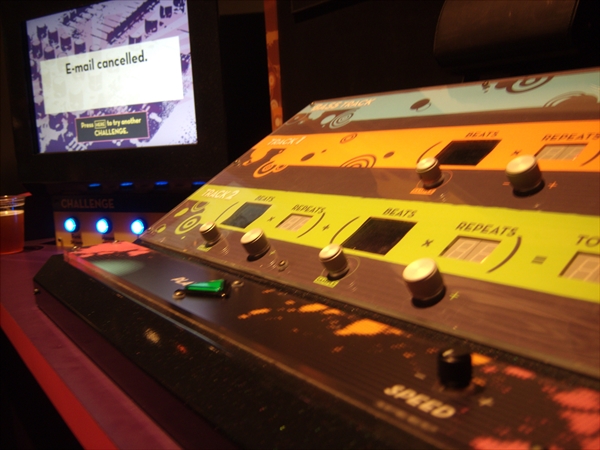
Pictured: DJ Tracks' touchscreen and custom hardware at OMSI After Dark "The pleasure we obtain from music comes from counting, but counting unconsciously. Music is nothing but unconscious arithmetic." - Gottfried Wilhelm Leibniz In Autumn of 2010, OMSI launched their new Design Zone exhibit. The hands-on museum's latest creation focuses on the science behind modern art, music, and engineering. It showcases everything from roller coasters to lasers, and drum machines to turntables. While OMSI's team headed up the design and (nearly bulletproof) hardware fabrication side of Design Zone, they invited several shops in the Portland area to head up the software. Fashionbuddha worked with Joshua Noble and OMSI in creating an openFrameworks -based application which communicates with a myriad of serial devices, a touchscreen, and the Internet to form "DJ Tracks". DJ Tracks at OMSI After Dark "DJ Tracks" is made up of a computer, touch screen, stereo, and a few custom enclosures housing seven-segment displays (SSDs), buttons, knobs, and OLEDs. You start by pressing one of four "challenge" buttons which will establish a "bass track" with a certain number of beats. The task is to a apply a little music math to match two other tracks to the bass track. For the first track, you dial knobs to choose an instrument loop, which contains four or eight beats, and the number of times to repeat the loop needed to match the bass track's duration. On the second track, you do the same, but by adding two banks of loops and repeats. Hit the play button when you're ready and watch your song play out on the touchscreen or SSDs to see if you were successful. You can tweak the tempo with another knob during playback for fun. If the number of beats in all three tracks are the same, you may e-mail a copy of the song to yourself as a MP3 attachment by typing on the touch screen. Basically, the goal is to provide a fun way to teach kids algebra in the form of music math. All the buttons, knobs, and screens can be boiled down to two simple equations: x = y * n x = y * n1 + z * n2 Where x is the bass track's number of beats, y and z are the beats per loop, and the n values are the number of loops. Design Zone is on exhibit at OMSI until May 30, 2011 and then will be traveling after that. Try to check it out if you get a chance. The whole exhibit is a lot of fun.

